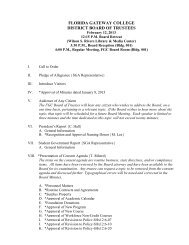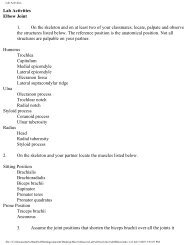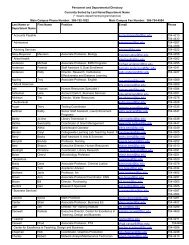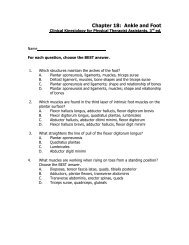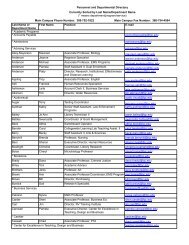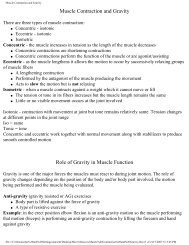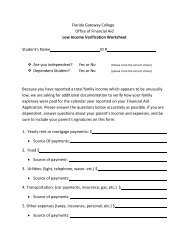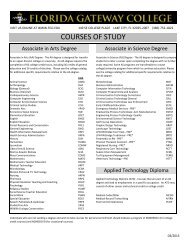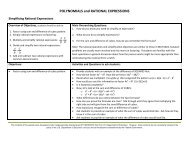Biomechanics
Biomechanics
Biomechanics
You also want an ePaper? Increase the reach of your titles
YUMPU automatically turns print PDFs into web optimized ePapers that Google loves.
<strong>Biomechanics</strong><br />
The system of leverage in the human body is built for speed and range of movement at the<br />
expense of force. Short force arms and long resistance arms require great muscular strength to<br />
produce movement. In the forearm, the attachments of the biceps and triceps muscles clearly<br />
illustrate this point, since the force arm of the biceps is 1 to 2 inches and that of the triceps less<br />
than one inch. Many other similar examples are found all over the body. From a practical point of<br />
view, this means that the muscular system should be strong to supply the necessary force for<br />
body movements, especially in strenuous activity.<br />
Most human activity, and especially strenuous activity, involves several levers working together.<br />
As with throwing a ball, levers in the shoulder, elbow, wrist, hand, and lower extremities<br />
combine to propel the ball. It almost assumes the effect of one long lever from hands to feet. The<br />
longer the lever, the more effective it is in imparting velocity.<br />
Laws of Motion<br />
There are basically two types of motion: linear and angular. Linear is also referred to as<br />
translatory motion, is motion along a line. If the motion is along a straight line, it is rectilinear<br />
motion. If it moves along a curved line its known as curvilinear motion. Angular motion involves<br />
rotation around an axis. In the human body the axis of rotation is provided by the various joints.<br />
In a sense, these two types of motion are related, since angular motion of the joints can produce<br />
the linear motion of walking. Newton's Laws explain all the characteristics of motion and are<br />
fundamental to understanding human movement.<br />
Law of Inertia<br />
A body in motion tends to remain in motion at the same speed in a straight line; a body at rest<br />
tends to remain at rest unless acted on by a force<br />
Inertia may be described as the resistance to action or change. The resistance to acceleration or<br />
deceleration. It is the tendency for the current state of motion to be maintained, regardless of<br />
whether the body segment is moving at a particular velocity or is motionless.<br />
Muscles produce the force necessary to start, stop, accelerate, decelerate or change motion. To<br />
overcome inertia, a force is needed. Since force is required to change inertia, it is obvious that<br />
any activity that is carried out at a steady pace in a consistent direction will conserve energy, and<br />
any irregularly paced or directed activity will be very costly to energy reserves.<br />
Law of Acceleration<br />
A change in the acceleration of a body occurs in the same direction as the force that caused it.<br />
The change in acceleration is directly proportional to the force causing it and inversely<br />
proportional to the mass of the body.<br />
Acceleration is the rate of change in velocity. To attain speed in moving the body, a strong<br />
muscular force is generally necessary (weight). Weight or, mass (gravity) affects the speed and<br />
file:///C|/Documents%20and%20Settings/marsettt/Desktop/Mics%20saves/<strong>Biomechanics</strong>.htm (8 of 10)2/7/2007 3:30:21 PM






